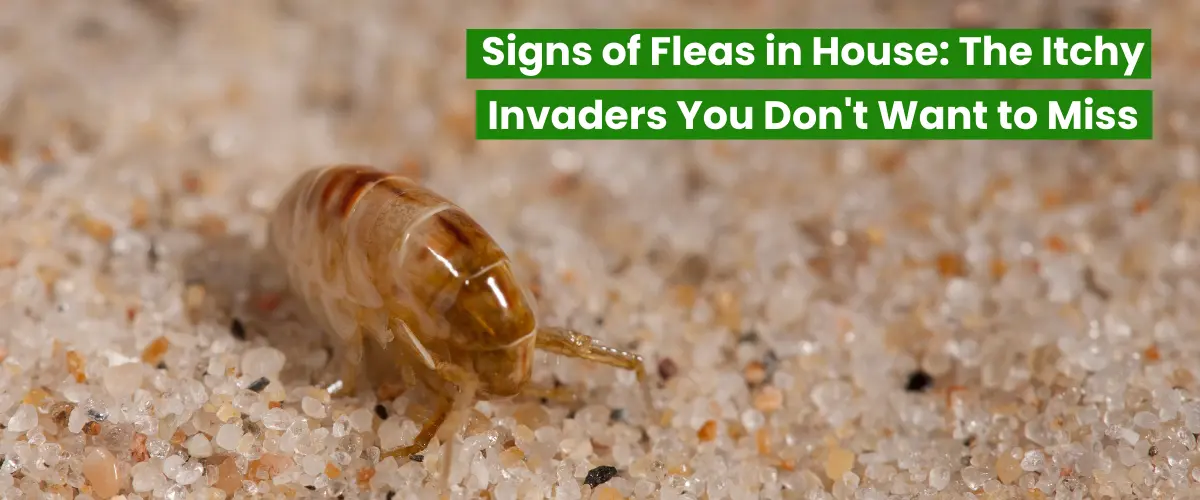Fleas are tiny, wingless parasites that thrive on the blood of warm-blooded animals. While they primarily target pets like dogs and cats, flea infestations can easily spread to your home, causing discomfort and irritation for everyone. Early detection is crucial to prevent a full-blown infestation and the associated health risks
The Itchy Impact of Fleas
Fleas aren’t just a nuisance; their bites can cause intense itching, redness, and even allergic reactions in pets and humans. Additionally, fleas can transmit diseases like tapeworms, posing a health risk for your furry friends. Furthermore, a flea infestation can leave your home feeling dirty and unhygienic.
Why Early Detection Matters
Fleas reproduce rapidly, and a small number can quickly turn into a large, difficult-to-control problem. By identifying the signs of fleas in house early on, you can take swift action to eradicate the fleas before they take over your house.
Mythbusters: Debunking Flea Misconceptions
There are many misconceptions surrounding fleas. Here are a few to clear up:
- Myth: Fleas only live on pets. (Fact): Fleas can survive for weeks off a host, living in carpets, furniture, and bedding.
- Myth: You can’t see fleas with the naked eye. (Fact): While adult fleas are small, they are visible to the human eye.
- Myth: Only dirty homes get fleas. (Fact): Fleas can infest even the cleanest homes brought in by pets or wildlife.
What Causes a Flea Infestation?
Understanding the Flea Life Cycle
To effectively combat fleas, it helps to understand their life cycle. Fleas go through 03 stages:
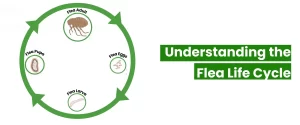
- Flea Eggs: Tiny (around 0.5mm), white, oval-shaped eggs, often found in clusters near pet bedding or carpets.
- Flea Larvae: Worm-like, translucent creatures, around 2-3mm long, feeding on organic debris and flea feces.
- Adult Fleas: Reddish-brown, wingless insects, around 2-3mm long, with jumping ability.
Sources of a Flea Infestation
- Pets: The most common source of indoor flea infestations are pets that spend time outdoors or come into contact with other flea-infested animals.
- Wildlife: Rodents, raccoons, and other wild animals can introduce fleas into your home through openings or crawl spaces.
- Second-hand furniture: Used furniture, especially pet beds or throws, may harbor flea eggs or pupae.
Environmental Factors
Warm and humid conditions favor flea development. Flea eggs and larvae thrive in areas with high moisture content, such as damp basements, poorly ventilated rooms, and under carpets.
How Do You Know If You Have a Flea Infestation?
The key to tackling a flea problem lies in recognizing the signs early on. Here’s a breakdown of the common symptoms and tell-tale signs of a flea infestation:
Physical Signs:
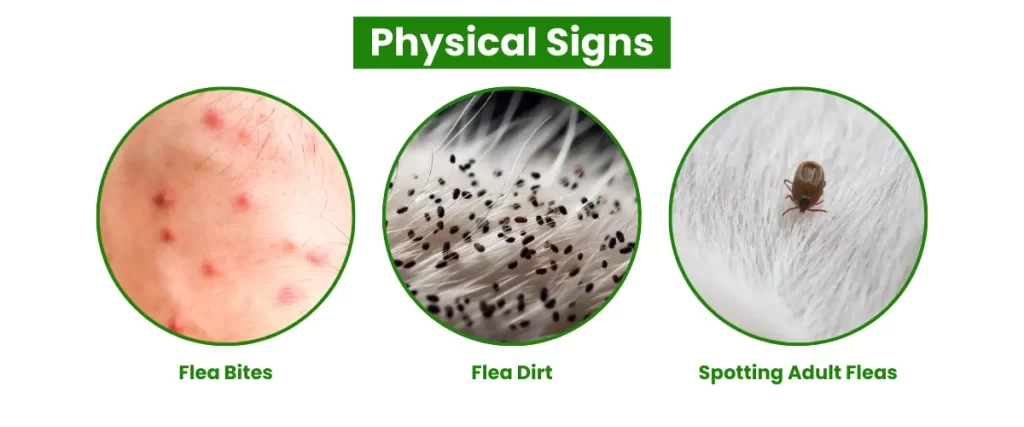
- Flea Bites: Both humans and pets can suffer from flea bites. These typically appear as small, red bumps, often clustered together in straight lines or patches. The bites can be very itchy and irritating.
- Flea Dirt: This is flea feces, and it looks like tiny black specks, resembling pepper flakes. Often found on your pet’s fur, bedding, or carpeting. To confirm it’s flea dirt, dampen a white paper towel and rub it on the specks. If the specks turn reddish-brown, it’s flea dirt (crushed flea blood).
- Spotting Adult Fleas: While small (around 2-3mm), adult fleas are visible to the naked eye. They are reddish-brown, wingless insects that jump quickly when disturbed. Parting your pet’s fur, especially around the base of the tail, neck, and behind the ears, might reveal live fleas.
Behavioral Signs:

- Increased Scratching and Grooming: Excessive scratching, biting, and chewing at the fur are classic signs of flea irritation in pets. You might also notice hair loss in areas where your pet scratches frequently.
- Irritability and Restlessness: Pets with fleas often become agitated and restless due to the constant itching and discomfort. They might exhibit more frequent licking, scooting on the floor, and difficulty sleeping.
Signs of Flea Infestation in House
Fleas don’t just live on pets; they can establish themselves in your home environment as well. Look out for these signs within your house:
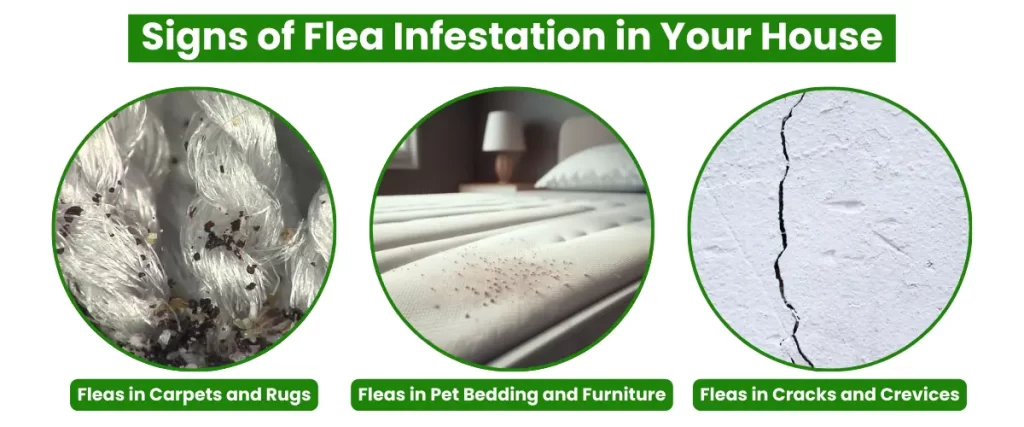
- Fleas in Carpets and Rugs: Fleas are attracted to dark, damp areas, and carpets and rugs provide the perfect breeding ground. Fleas might jump onto your ankles or legs as you walk on infested carpets.
- Fleas in Pet Bedding and Furniture: Your pet’s favorite spots like beds, throws, and furniture, are prime targets for fleas. Regularly check these areas for adult fleas, flea dirt, or flea eggs (tiny white ovals).
- Fleas in Cracks and Crevices: Fleas can hide in cracks in floors, baseboards, along walls, and under furniture. These areas provide a safe haven for fleas to lay eggs and develop.
Tools for Detection:
- Flea Combs: Running a fine-toothed flea comb through your pet’s fur can trap adult fleas. Look for signs of flea dirt or live fleas on the comb.
- White Sock Test: Put on white socks and walk around barefoot on suspect areas like carpets or furniture. Fleas are attracted to movement and might jump onto your socks, making them easier to spot.
Signs of Fleas in House Without Pets
Believe it or not, fleas can establish themselves in a home even without resident pets. Here’s how:
- Previous Occupants: If your home had flea-infested pets in the past, flea eggs or pupae might have remained dormant in carpets, furniture, or cracks. When conditions are favorable (warm, humid), these eggs can hatch, leading to a new flea infestation.
- Wildlife Visitors: Rodents, raccoons, squirrels, and other wildlife can carry fleas into your home through openings or crawl spaces. Even brief encounters with these animals can introduce fleas into your house.
- Visitors’ Pets: If friends or family bring their flea-infested pets over, fleas can easily jump off their fur and establish themselves in your home environment.
Signs to Watch Out For:
In a pet-free home, keep an eye out for these indicators of a potential flea infestation:
- Unexplained Bites on Humans: Flea bites are not specific to pets, and humans can be bitten as well. If you experience itchy, red bumps, particularly clustered around your ankles, legs, or arms, it could be a sign of fleas.
- Fleas in Furniture or Carpets: Even without pets, fleas can be present in carpets, rugs, furniture, or bedding. Regularly inspect these areas for signs of adult fleas, flea dirt (black specks), or even tiny white flea eggs.
What Does Flea Infestation Look Like?
A flea infestation can progress through various stages, each with its own visual signs:
Early Infestation:
- You might not see adult fleas yet, but the presence of flea dirt (black specks) on carpets, furniture, or near baseboards is a tell-tale sign.
- Unexplained bites on humans, especially around the ankles and legs, can indicate flea activity.
Developing Infestation:
- You might start spotting adult fleas, particularly near pet sleeping areas (even if you don’t have pets) or on furniture.
- Your pet (if you have one visiting) might exhibit scratching behavior due to flea bites.
Full-Blown Infestation:
- Adult fleas become more visible, jumping readily when disturbed.
- You might see flea eggs (tiny white ovals) on furniture, carpets, or pet bedding.
- Your pet (if you have one visiting) might have significant hair loss due to excessive scratching.
Where to Look:
Focus your inspection on areas where fleas like to hide and breed:
- Baseboards and Carpet Edges: Fleas thrive in dark, damp crevices. Check along baseboards, under furniture, and around the edges of carpets.
- Furniture Seams and Upholstery: Fleas can hide within the folds and seams of furniture upholstery.
- Pet Sleeping Areas: Even if you don’t have pets, check areas where previous pets might have slept or rested. This includes carpets, bedding, or specific furniture.
How Long Do Flea Infestations Last?
Unfortunately, flea infestations can linger for weeks or even months if left untreated. The duration depends on several factors:
- Severity of the Infestation: A mild infestation with a few fleas might resolve quicker than a full-blown one with a large population.
- Treatment Methods and Effectiveness: Choosing the right treatment and applying it consistently is crucial. Ineffective treatments or improper application can prolong the infestation.
- Life Cycle of Fleas: Fleas have a 03-stage life cycle, with eggs and pupae being particularly resistant to treatments. Eradicating them requires breaking this cycle at all stages.
Tips to Shorten Infestation Duration:
- Target All Stages: Use a combination of treatments that address adult fleas, eggs, and larvae. This might involve using topical medications for pets, flea bombs for the home environment, and growth regulators to prevent egg development.
- Treat Pets and Environment Simultaneously: Fleas can easily move between pets and your home. Treat all pets residing in the house, and thoroughly clean the environment to eliminate eggs, larvae, and pupae.
- Maintain a Consistent Schedule: Don’t skip treatments or follow-ups as recommended by your veterinarian or pest control professional. Consistent application is key to breaking the flea cycle.
Preventing and Treating Flea Infestations
An ounce of prevention is worth a pound of cure! Here’s how to keep fleas at bay:
Preventive Measures:
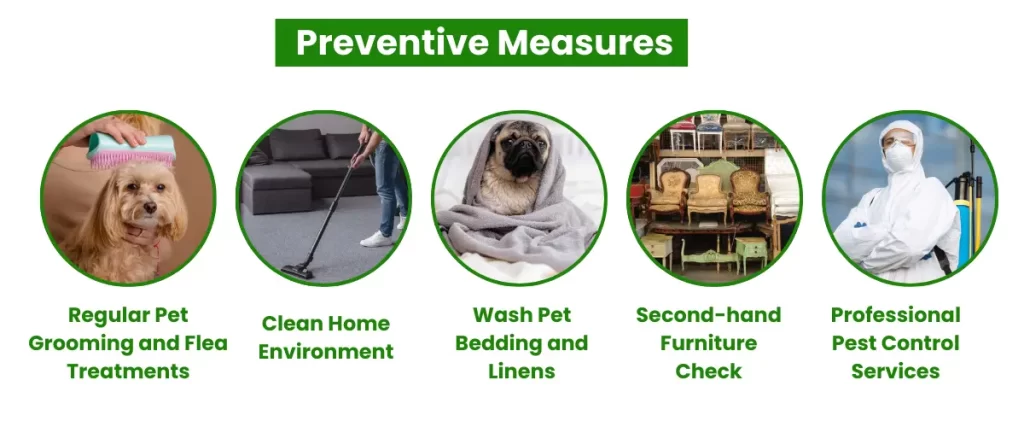
- Regular Pet Grooming and Flea Treatments: Regularly groom your pets and use veterinarian-recommended flea prevention medication (topical treatment, chewable tablets) to keep adult fleas in check.
- Clean Home Environment: Vacuum carpets, rugs, and furniture frequently, paying close attention to areas where pets spend time. Dispose of the vacuum cleaner bag after each use to prevent flea eggs from hatching.
- Wash Pet Bedding and Linens: Wash pet bedding, throws, and other linens in hot water (at least 140°F) to kill flea eggs and larvae.
- Second-hand Furniture Check: Before bringing in used furniture, especially pet beds or throws, inspect them thoroughly for signs of fleas or flea dirt. Consider treating the furniture before introducing it into your home.
Treatment Options:
If you suspect a flea infestation, address it promptly. Here are some treatment options:
- Professional Pest Control Services: For severe infestations, consider hiring a professional pest control service. They have access to stronger insecticides and can ensure a thorough treatment of your home.
- DIY Treatments: Various DIY flea treatments are available, including topical medications for pets, flea bombs, and sprays. While effective for mild infestations, consult your veterinarian before using any products on your pets.
Remember: No matter the chosen treatment approach, always treat both your pets and the home environment simultaneously to ensure long-term success. Early detection, consistent treatment, and a multi-pronged approach are key to winning the war against fleas and maintaining a flea-free home.
Conclusion: Banishing the Itchy Invaders – A Flea-Free Future Awaits!
Fleas are tiny pests that can cause big problems. By understanding the signs of a flea infestation, you can take control of the situation and prevent them from taking over your home. Remember these key points:
- Early Detection is Key: Look for signs like flea bites, flea dirt, and excessive scratching in your pets. Regularly inspect your home environment for adult fleas or flea dirt, especially in carpets, furniture, and pet bedding.
- Multi-Pronged Attack: Address the infestation in its entirety. Treat your pets with veterinarian-approved flea medication and thoroughly clean your home environment to eliminate eggs, larvae, and adult fleas.
- Break the Cycle: Consistent treatment is crucial. Follow the recommended schedule for pet medication and repeat cleaning routines to prevent new flea outbreaks.
If you suspect a severe infestation or DIY treatments prove ineffective, don’t hesitate to seek professional help.
Call to Action:
For a guaranteed flea-free home, contact Best@Pest today! They offer effective flea treatment plans and can help you reclaim your home from these itchy invaders.

